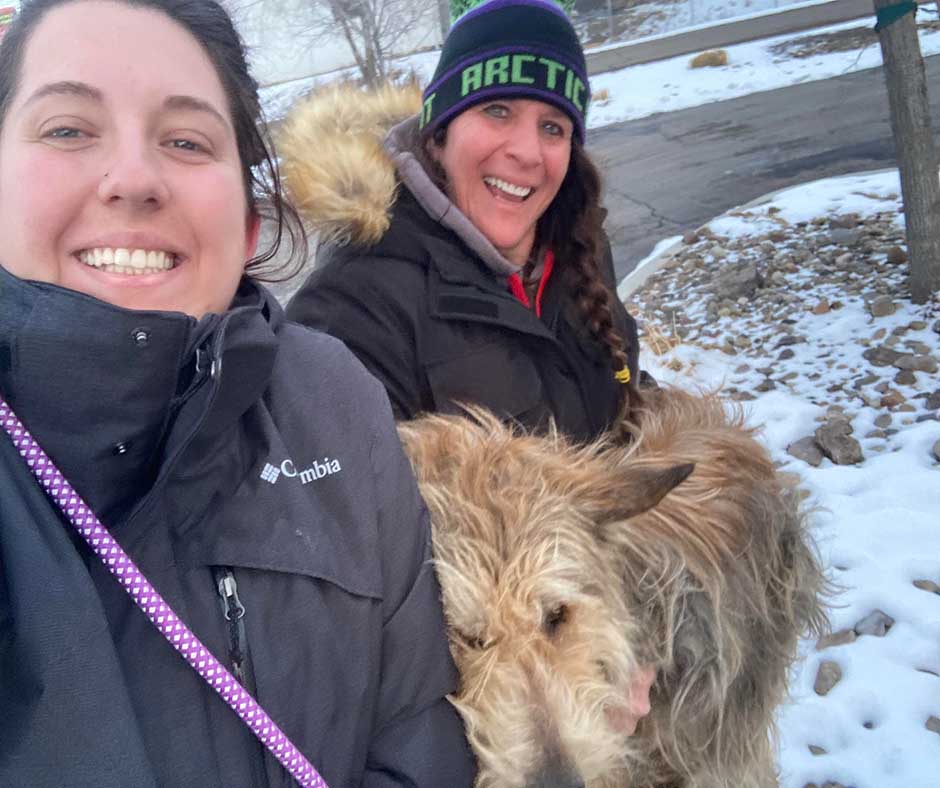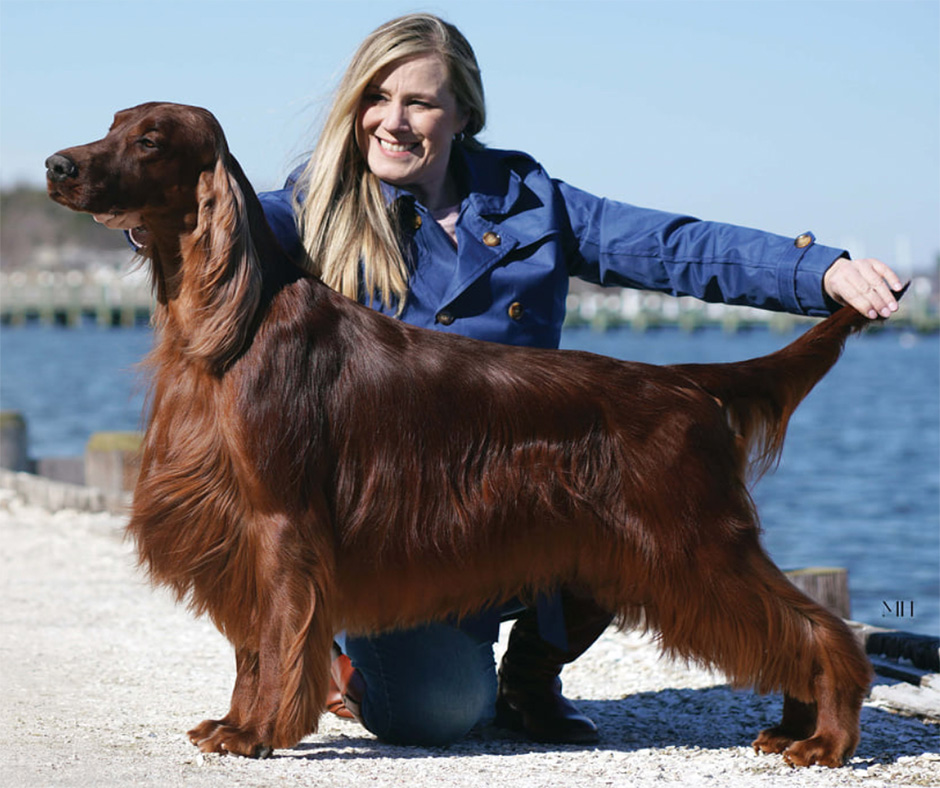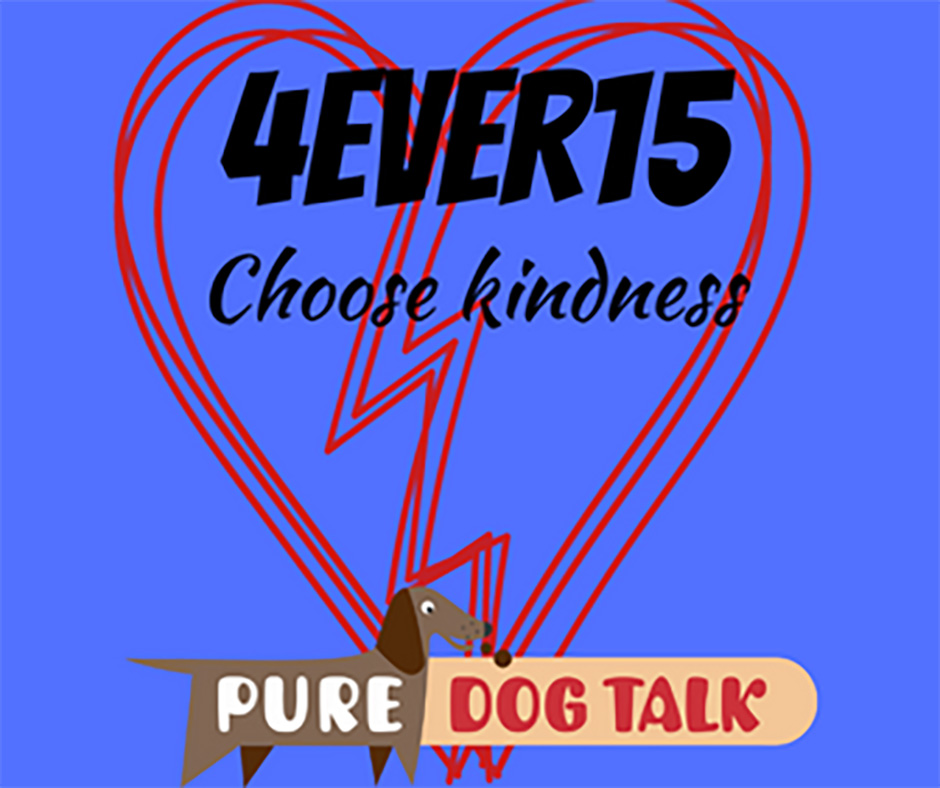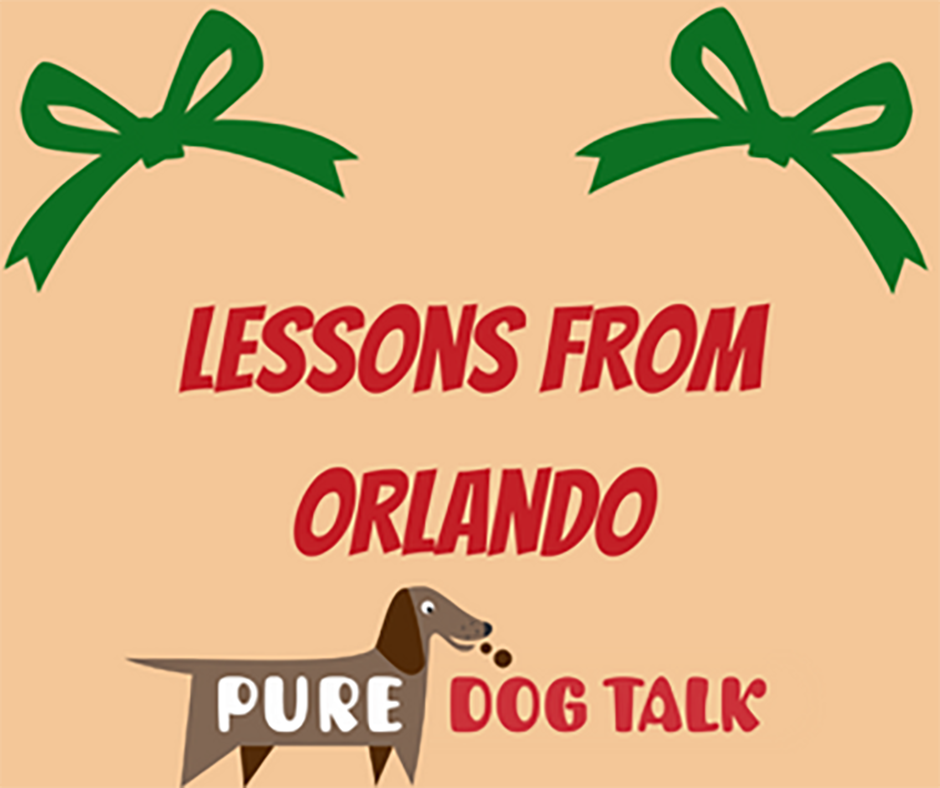Posts by Laura Reeves
569 – OFA Launches New Testing for Brachycephalic Breeds
OFA Launches New Testing for Brachycephalic Breeds

Dr. Kathleen Smiler, DVM, Pug Dog Club of America Health Committee Representative.
Eddie Dziuk, Chief Operating Officer at the Orthopedic Foundation for Animals, and Dr. Kathleen Smiler, DVM, Health Committee Representative from the Pug Dog Club of America, join host Laura Reeves to introduce the new BOAS testing program.
“Brachycephalic Obstructive Airway Syndrome (BOAS) is a condition which may cause breathing difficulties in breeds such as Bulldogs, French Bulldogs and Pugs,” according to the OFA. “BOAS is caused when the soft tissue in the nose and throat are excessive for the airway, partially obstructing the airway and making it difficult for them breathe normally.
“BOAS is a progressive disorder and can impair a dog’s ability to exercise, play, eat and even sleep. Clinical signs of BOAS are variable and may include noisy breathing, exercise and heat intolerance, regurgitation and dysphagia. Unfortunately, many owners are unaware of the disease, and often interpret breathing noises or difficulties as simply normal for the breed.
“In an effort to learn more about the condition, increase awareness, and ultimately reduce the incidence of BOAS, researchers at the University of Cambridge in the UK developed the Respiratory Function Grading Scheme (RFGS). The goal of the RFGS was to develop an objective test to measure the clinical diagnosis and severity of BOAS. The OFA has joined this international effort and has licensed the RFGS for use in the US and Canada.
“The exam is conducted by a specially trained and approved veterinarian and consists of 4 steps:
- A short health survey regarding the dog’s breathing history
- A brief physical exam while the dog is calm including auscultation where the assessor listens to the dog’s breathing with a stethoscope gently positioned on the side of the neck. This establishes a baseline for any clinical signs of BOAS.
- A short exercise test consisting of a brisk three minute walk. This is designed to expose clinical signs of the disease in an otherwise calm and asymptomatic dog. It is not designed to assess cardiovascular fitness.
- A post exercise auscultation after increased airway activity to compare to the pre-exercise baseline.”
“I think the veterinarians were extremely enthusiastic,” Smiler said of the veterinarians participating at a recent event in Portland, Oregon. “And I think the participants were quite pleased too, I think. I went and sat in the meet the breeds box with the pug people in Portland and everybody was quite satisfied. I think our club in general was very satisfied.”
“We examined 54 dogs (at the rollout in Portland),” Dziuk said. “We actually did 60 where we had a couple breeds that weren’t on the official breed participant list yet. So, we had 54 between Bulldogs, Frenchies and Pugs and we also had a couple of Bostons and Pekes.
“Overwhelmingly (we had) pretty good results. We had 10 Grade 0. So, the grade zeros are basically everything was good. These dogs were good breathers, they had nice wide open nostrils. There were no sounds of turbulence or anything during the auscultation, so everything was looking pretty good. We had 18 grade 1, which is also good. It means that in general, nothing could be heard without a stethoscope and you could only hear some of the minor issues with the stethoscope, but the dogs are basically still found to be clinically unaffected by BOAS. We did have 25 grade twos and we had one lone grade three.
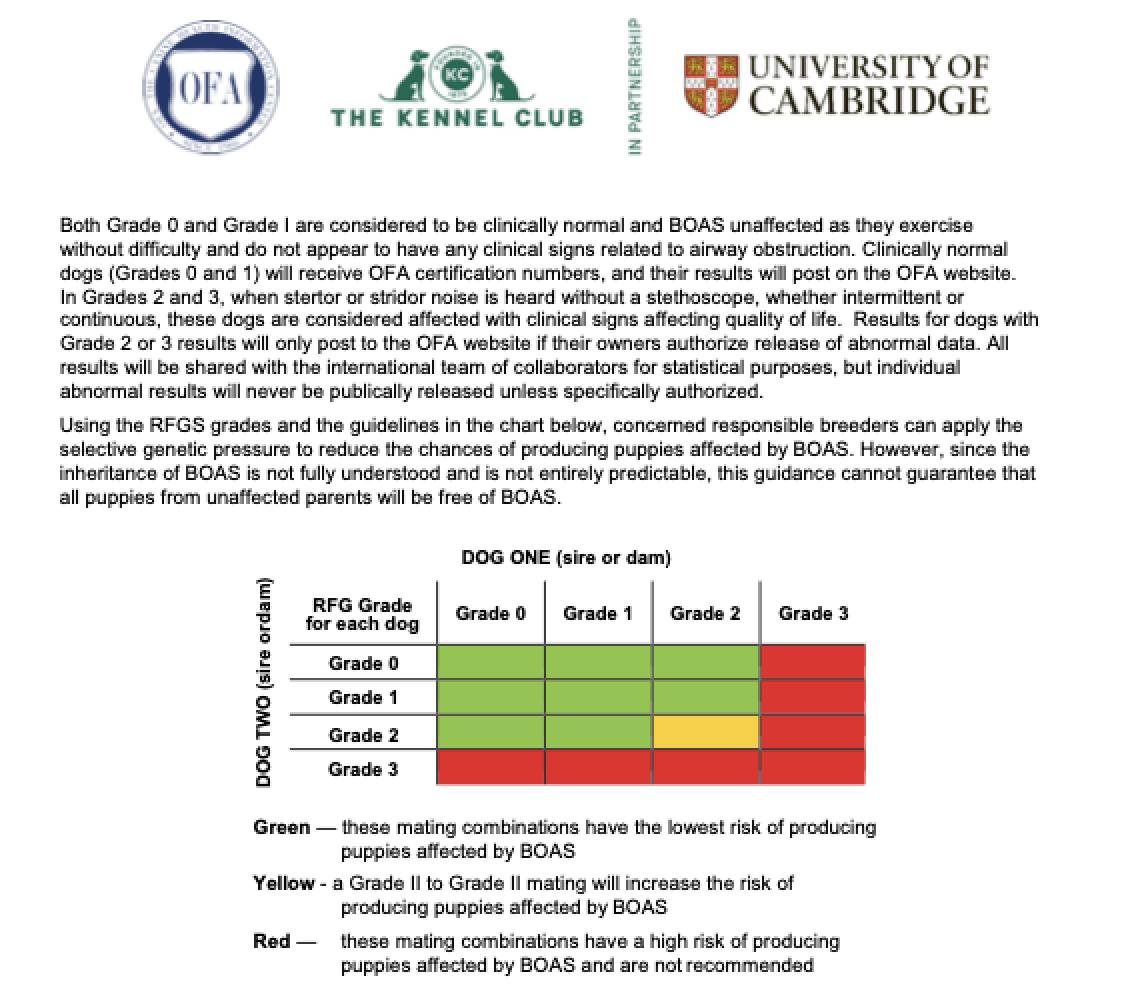 “I think that goes to prove the point that not all Bulldogs suffer breathing difficulties, not all Frenchies suffer breathing difficulties, and not all pugs do either. That there is a large group in all three of those breeds where they’re good healthy dogs that breathe fine, that don’t show signs of exercise intolerance, and we can work with those dogs and breed them and hopefully breed lots of future generations of good, healthy Frenchies, Pugs and Bulldogs.”
“I think that goes to prove the point that not all Bulldogs suffer breathing difficulties, not all Frenchies suffer breathing difficulties, and not all pugs do either. That there is a large group in all three of those breeds where they’re good healthy dogs that breathe fine, that don’t show signs of exercise intolerance, and we can work with those dogs and breed them and hopefully breed lots of future generations of good, healthy Frenchies, Pugs and Bulldogs.”
“We’re certainly very sensitive to the criticism that’s been directed toward brachycephalic breeds,” Smiler said. “I think we’re fortunate here in the US, where (breeding) isn’t a regulated activity, nor has the Veterinary Association attacked the breeds as they did in Europe. We’re going to make this information available to our members and highly encourage them (to participate). Then eventually I’d love to educate the puppy buyers. I think it’ll be very positive across the board.”
Listen in to the full episode for more details.
568 – AKC’s New Genetic Testing Program to Offer Expanded Insights
AKC’s New Genetic Testing Program to Offer Expanded Insights
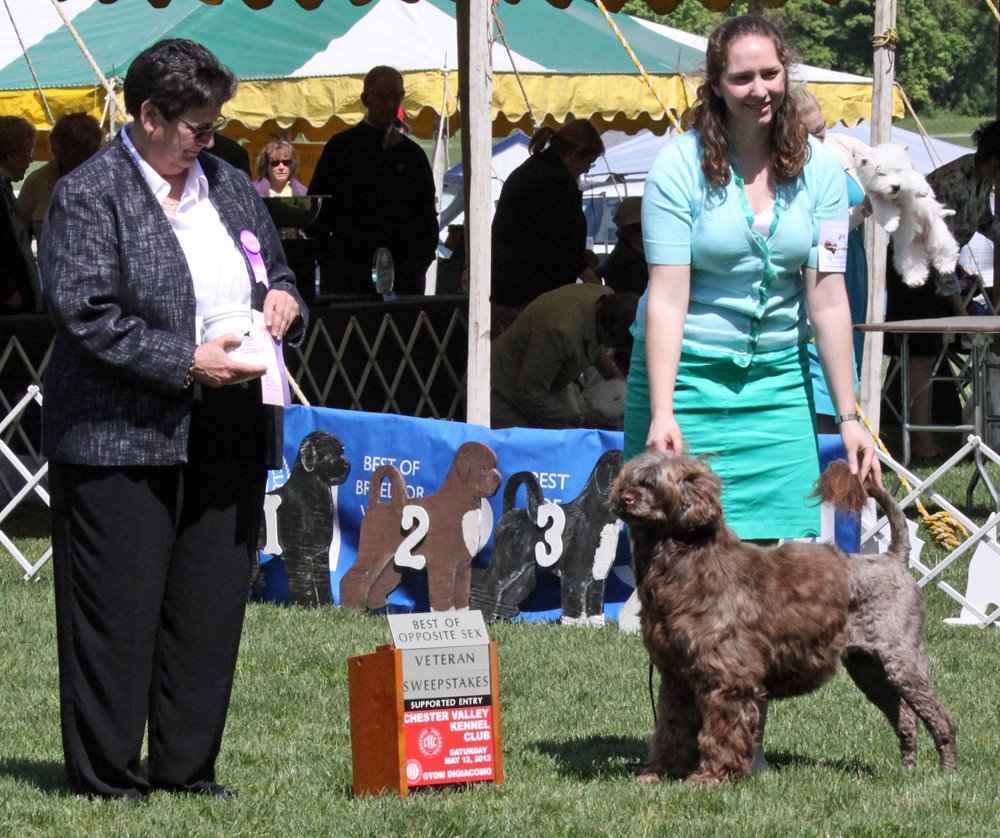
Dr. Claire Wiley, VMD and her Portugese Water Dog.
Dr. Claire Wiley, Executive Director of the AKC DNA Program, joins host Laura Reeves with breaking news about the expansion of their testing capabilities.
AKC’s DNA program will soon include the option to identify traits and genetic diseases, in addition to simple parentage, Wiley announced.
“For the past 25 years, the AKC DNA program has really focused on protecting the registry,” Wiley noted. “And they did that using unique identification, kind of like fingerprints and also using those fingerprints to verify parentage. It had more of a regulatory role to it.
“A couple years ago, the AKC developed an ad hoc genetics committee. They listened to the breeders (who) were really interested in having more from the DNA program. And that’s kind of why I got hired, because we’ve listened to the feedback and are trying to bring things into the future to really serve our most important constituents, the breeder.”
Wiley, a second-generation Portugese Water Dog breeder, is a board certified veterinary specialist in Small Animal Internal Medicine. Her passion for genetic health testing started early in life after losing two PWD puppies to juvenile dilated cardiomyopathy. She later worked on the breakthrough studies to identify the genetic marker for protein losing nephropathy in Soft Coated Wheaten Terriers.
“I’m a breeder. I lived through it from the very beginning and now I’m back here to help bring the DNA program into the future,” Wiley said. “At AKC, we try to focus on all dog owners, but it all starts with the breeders who are producing the healthy dogs for all dog owners.
“The fundamental process will essentially be the same where you use a cheek swab to collect DNA and you go online to activate it. When you first go in to buy the swabs, there will be two products. The original parentage product will be called the AKC Original DNA profile and then the one that includes health tests and traits will be called the AKC Signature DNA profile.
“So when you’re actually on what we call our shop page where you’re buying the swabs, you have an option of choosing either just the Original profile, which is the $50 kit that provides parentage, or you can choose the option that still includes that $50 original profile, but also has health and traits available.
“We’re really hoping to launch this by mid 2023 at the latest, hopefully April. A lot of these companies say there are over 200 markers that they’re testing for, but if you actually talk to breeders, they’re probably focused on 2, 3, maybe 0 for that specific breed. So, we are taking the experts, you know, the Breeders, and having them tell us what we should be including as important markers for them.
“The parent clubs have what we call parent club health statement letters where they actually say this is what we are concerned about as a breed and as a group, and so we’re using those letters to determine which testing is the most important for that breed.”
Listen to the full episode for more from Dr. Wiley.
567 — Canine Bladder Stones: Diagnosis and Treatment
Canine Bladder Stones: Diagnosis and Treatment
Dr. Marty Greer, DVM joins host Laura Reeves for a deep dive on bladder stones in dogs, how to diagnose and treat them. The following information is provided by Dr. Greer.
Bladder stones are the quintessential “which came first, the chicken or the egg” question. By this, we mean that a dog can have a bladder symptoms that are caused by a bladder stone, or the bladder infection can cause bladder stones to form. Which then becomes a vicious cycle.
There are two basic types of bladder stones – the first, struvite stones associated with a bladder infection or second, any of the following other bladder stones, caused by a metabolic disturbance that causes a stone to form in the urinary tract.
How do bladder infections cause bladder stones? An undiagnosed, under-treated or recurrent bladder infection can lead to the development of struvite bladder stones. This is the most common type of bladder stone. Or another type of stone can cause irritation to the bladder which can cause a stone to form that is partly any of the types of stone below combined with a struvite stone. These form like a pearl in an oyster – the irritation of the infection or other stone type can cause a struvite coating on an existing bladder stone.
Many metabolic stones are associated with a particular breed or disease condition causing minerals to deposit in the bladder, forming stones. These metabolic stones form with long term supersaturated minerals in the urine. With time, the crystals form which develop into a bladder stone. Other factors are the pH of the urine, inhibitors and promotors of stone formation, and macrocrystalline matrix. If something like suture is in the bladder, this can also allow a stone to form.
Fortunately, most stones in the urinary tract are in the bladder itself, where they are accessible surgically. Stones in the kidney or ureter (tube from the kidney to the bladder) are not easily managed surgically or by physical removal. Stones that form in the bladder and pack together like sand in a funnel or slip from the bladder into the urethra (tube from the bladder to the outside of the body) cause urinary obstruction. This is a true medical emergency, more common in males that females due to the length and shape of the urethra, the tube from the bladder to the outside.
Males have a design flaw – their urethra is more narrow and curved, causing a greater likelihood of urinary obstruction. On the other hand, females have a design flaw, a shorter wider urethra just below the rectum that allows bacteria to ascend into the bladder, increasing the risk that a female will have a bladder infection. That infection can often lead to the formation of struvite stones.
Symptoms
Symptoms of bladder disease can be virtually non-existent to severe. The symptoms can vary:
- No signs or very subtle signs of discomfort or urinary accidents.
- Signs of blood in the urine (often not noted until there is snow on the ground or when the urine is wiped up and blood is seen on a white towel), straining to urinate, frequency of urination, inappropriate urination, +/- fever, pain, and/or urinary incontinence. Dogs are rarely “sick” with a bladder infection – they eat, drink, and act normally other than increased trips outside or urinary accidents on the floor.
- If obstructed, there will be abdominal pain, vocalizing, vomiting, dehydration, depression, heartbeat irregularities, bladder distension, in advanced cases, bladder rupture, collapse and death.
- Blood work can show elevated BUN and creatinine, kidney values if obstructed.
- Blood work may show elevated calcium if calcium oxalate stones are present.
- Blood work may show liver dysfunction in patients with urate stones.
Below is a table showing the different types of bladder stones, comparing the composition, cause, prevention and treatment options.
| Type of stone | Cause | Prevention | Treatment |
| Struvite or magnesium ammonium phosphate hexahydrate. Usually located in bladder but can be in renal pelvis. This is the most common stone in dogs at an incidence of 53%. | More common in female than male dogs, usually young dogs. Frequently multiple. Secondary to undermanaged bacterial bladder infection incl most commonly Staphylococcus spp., but less commonly seen urease-producing bacteria include Proteus spp. or Enterococcus spp. Rarely Escherichia coli, Pseudomonas spp.,
Klebsiellaspp., Corynebacterium urealyticum, or Ureaplasma/Mycoplasma spp. May have a genetic component. Breeds: American cocker spaniel |
1. Find and manage cause of recurrent bacterial bladder infection.
2. Preventive diets lower in protein, phosphorus and magnesium including: Royal Canin® Veterinary Diet Urinary SO, Hill’s Prescription Diet c/d™, Hill’s Prescription Diet w/d™, and Purina Pro Plan Veterinary Diets UR Urinary St/Ox. 3. Increased water intake 4. Weekly monitoring of urine pH and intervention if pH rises. 5. Periodic imaging for early detection of recurrence. |
1. Dissolution diet combined with appropriate long-term antibiotics. May be dissolved medically unless obstructed.
2. Acidifiers such as D,L-methionine combined with appropriate long-term antibiotics. 3. Surgical removal or Cystoscopic retrieval 4. Physical removal. |
| Calcium oxalate or calcium oxalate combined stones. Usually in the bladder but can be in the renal pelvis. 2nd most common bladder stone seen in dogs. | More common in males, middle aged.
Patients who have increased urinary excretion of calcium /or oxalate. May include Cushing’s disease, primary hyperparathyroidism, or cancer causing elevated calcium levels. Obesity. Steroid administration. Genetic predisposition. Bichon frise |
Calcium oxalate uroliths recur 8-9% after 6 months, 35-36% after one year, and approximately 50% after 3 years.
1.Diet Royal Canin® Veterinary Diet Urinary S/O Lower Urinary Tract Support, Purina Pro Plan Veterinary Diets UR Urinary St/Ox™, Hill’s Prescription Diet w/d™, and Hill’s Prescription Diet u/d™. 2.Potassium citrate orally. 3.Thiazide diuretics. 4.Vitamin B6 |
There is no known way to dissolve this stone type so must be physically removed. |
| Cystine | More common in males, young to middle aged.
Occurs secondary to cystinuria, which is caused by increased levels of cystine excreted into urine. Uncommon. Inherited mutation of SLC3A1 gene, which leads to defective amino acid transport, described in the Newfoundland, Labrador retriever, and in the cat. Missense mutation in SLC7A9 is another cause of cystinuria in the dog. Androgen-dependent cystinuria has been described in dogs. Genetic Test: DNA testing for genetic traits is available at vetGen, Penn Gen, Paw Print Genetics, DDC, Animal Genetics, and UC Davis Veterinary Genetics Laboratory in the USA, as well as Animal Genetics-UK, Laboklin, and Animal DNA Diagnostics in Europe. Breeds: American pit bull terrier |
1. Feed protein-restricted, low-sodium diet.
2. Potassium citrate to maintain alkaline urine. 3. Some patients may also require 2-MPG therapy. 4. Do not breed affected dogs, their parents, or any other offspring. 5. For breeds with androgen-dependent cystinuria, castration can help in controlling cystinuria. |
1. Low protein, low sodium, alkalizing diet: Hill’s Prescription Diet u/d™ and Royal Canin® Veterinary Diet UC Low Purine
2. Potassium citrate to alkalinize urine with a pH goal of 7.2 to 7.5 and dilute urine. 3.Physical removal. |
| Xanthine incidence 0.5 to 1% incidence of bladder stones in dogs | An uncommon type of purine urolith.
Adults 2 to 6 years of age. No sex predilection. Causes: Allopurinol administration Idiopathic, unknown |
Purine-restricted, alkalinizing, diuretic diet helps prevent xanthine recurrence including renal failure diets or ultra-low protein diets with low purine levels (Hill’s Prescription Diet u/d™ or Royal Canin® Veterinary Diet Vegetarian) may help. Add water to food to keep urine dilute. Use potassium citrate may be needed to keep urine pH alkaline. | Will not dissolve. Must be physically removed.
Stop allopurinol treatment if possible. |
| Silica incidence 0.9% of canine bladder stones | Incidence world-wide seems regional. Primarily male dogs. Usually 6 to 8 years of age.
May be genetic with German Shepherds, Labradors, Golden Retrievers and Old English Sheepdogs being over-represented. Cause unknown.
|
Monitor with urine testing and imaging to check for recurrence. May help to feed more animal protein and less vegetable protein to reduce recurrence. Feeding diets higher in animal protein and lower in plant-based proteins (such as soybean, rice, corn gluten feed, oat-based cereals) may be beneficial. Increasing water intake may help decrease silica concentration in urine. Do not allow patients to eat grasses and soils with higher silica content. | No dissolution therapy known.
Must be physically removed. |
| Calcium phosphate – incidence 1 to 2% of canine bladder stones | Brushite more common in males.
Breeds predisposed include Shih tzu Lhasa apso Miniature Schnauzer Yorkshire terrier Miniature poodle Pomeranian Bichon frise American Cocker Spaniel |
Identify and treat the underlying cause such as primary hyperparathyroidism or Cushing’s diease (hyperadrenocorticism). Keeping urine pH of 6.5-7.5 and urine dilute helps reduce risk of recurrence. Ideal preventive diet is unknown; diets aimed at preventing calcium oxalate uroliths are reasonable options. | Associated with primary hyperparathyroidism or Cushing’s disease (hyperadrenocorticism). These also may occur as part of stones that are largely composed of struvite or calcium oxalate. Associated with alkaline pH. |
| Urate incidence 5 to 8% of canine bladder stones | Either sex, usually young dogs. Uric acid and its various salts. Associated with liver disease, hepatic dysfunction, portosystemic shunts, inherited, or less commonly, caused by urinary tract infections (UTI) with urease-producing bacteria.
Genetic mutation in the SLC2A9 gene: Australian shepherd |
Frequently recurrent at rates of 33 to 50%.
Annual or biannual imaging with ultrasound or x-rays to monitor. |
1. Dietary therapy with low purine diets (eggs, dairy and vegetable protein) – may be dissolved medically unless obstructed: Hill’s Prescription Diet u/d™, Royal Canin® Veterinary Diet Canine Vegetarian, and Royal Canin® Veterinary Diet Urinary UC Low Purine.
2. Potassium citrate at 50-150 mg/kg PO q 12 hrs or sodium bicarbonate at 25-50 mg/kg PO q 12 hrs may be used. Avoid pH above 7.5 3. Allopurinol 4. Physical removal 5. Managing underlying liver disease. |
| Combination stones | Any combination of the above stones can occur. The largest % component is reported when there are several mineral components to the stone. | Based on analysis | Based on analysis |
| Dried solidified blood | Cats only |
The above table is a summary of information published on www.veterinaryinformationnetwork.com. Thanks to this author Kari Rothrock DVM.
Diagnosis
- Symptoms are noted.
- Urinalysis: crystals seen on microscopic evaluation of the urine, bacteria, white blood cells, and white blood cells seen under the microscope.
- Culture – to identify the causative bacteria.
- X-rays – seeing stones in the bladder, kidney, ureter or urethra. May require contrast x-rays.
- Ultrasound – stones or gritty material seen blocking the ultrasound beam on ultrasound. This may be described as a “snow globe”.
- Stone analysis – essential to know the cause and how to try to prevent formation of future stones.
- Cystoscopy – when an endoscope is passed into the bladder to look for stones. Removal may be achieved at this procedure.
Physical Removal of stones: there are several techniques available to remove stones from the urinary tract.
- Surgical removal – is a procedure available at most small animal veterinary clinics with basic surgical availability. If an obstruction is present, immediate surgical intervention is essential.
- Cystoscopic retrieval – requires an endoscope and special baskets to retrieve stones from the urethra and/or bladder.
- Voiding urohydropropulsion – With sedation or anesthesia, the bladder is catheterized, filled with fluids multiple times, and with pressure on the bladder, efforts to push the stones out through the urethra is attempted. This works best in small dogs with small stones.
- Extracorporeal Shock Wave Lithotripsy (ESWL) – This involves using a shock wave to a patient immersed in a water bath. Bladder stones may move too much for this to have a successful outcome so is better suited for stones in the kidney or ureter.
- Laser lithotripsy – This involves using a laser to fragment them, then the fragments are removed. This works better in female than male dogs. Small dogs and large bladder stones may not lend themselves to this treatment option.
- Retrograde Urohydropropulsion (RU) – this involves flushing stones from the urethra back into the bladder for removal. In general, the patient will require sedation or anesthesia, followed by removal of some urine to relieve the pressure on the bladder.
Other than surgical removal, the others are usually only available at larger referral centers or veterinary schools.
Dissolution – is a process by which bladder or kidney stones can be dissolved using special diets, drugs, and or antibiotics. Not all stone types will dissolve. And not all dissolvable stones will dissolve safely. If the dog has an obstruction and cannot urinate, immediate physical removal of the stones is essential as urinary obstructions are life-threatening. Not all dogs will eat the diet required to dissolve the stones. Not all owners are willing or able to administer the medications and diets necessary to dissolve the stones. Frequent monitoring of the size and location of the stone is essential to safely allow stones to dissolve. The required diets are prescription diets, and the medications are also prescription drugs. Care in selecting the correct food and medication is required, thus the reason for prescriptions from the pet’s veterinarian.
Prevention can often be successful. Again, this requires that the owner(s) of the dog take great care to provide plenty of fresh water frequently, let the dog out to urinate frequently, and administer medication and food without “cheating”. Owners may also need to check weekly urine samples to assess the urine pH for early adjustments in medication and food to prevent recurrences.
As a result, a mutual treatment plan with the pet owners and their veterinary team is essential for a successful outcome.
566 – Routines Create Coping Skills in Traumatic Times
Routines Create Coping Skills in Traumatic Times

Dr. Angel Iscovich, MD, author of “The Art of Routine”
Dr. Angel L. Iscovich, M.D. joins host Laura Reeves to talk about creating routines as a coping mechanism in traumatic times. An emergency room physician and Miniature Schnauzer enthusiast, Iscovich’s book “The Art of Routine” has great suggestions as we emerge from the trauma of the pandemic years.
Iscovich studied older patients and found that consistently, folks who lived well into their older years had one thing in common. Routines. Even routines that aren’t necessarily “healthy” were beneficial, Isocvich noted.
“I noticed people that were over 100 years of age, centenarians, I noticed two qualities that they had,” Iscovich said. “One is that they have a stable environment. By that I mean both physical and people around them. And two, they had a very, very regular routine. They had a rhythm, a routine, things that they did with great regularity.
“But what I also noticed is what they did varied quite a bit. So, some of them were doing not necessarily healthy things, but that got me to thinking. That may be part of the key is more the *how* than the *what* we’re doing. In other words, the routine may be more important than actually what you’re eating because here’s this 100-year-old having Dr. Peppers every day, you know, and that doesn’t seem like the right thing to do, but that there was something to the fact that you had routine and regularity.
“It seemed to me that for us as humans in this world where we’re using our digital world as we are today in computers and sort, that we’re being constantly interrupted and disrupted and being always tempted to do different things all the time, and that maybe, maybe changing things up too much is not really the way to go.
“We seek and survive by having kind of stability. Homeostasis is what it’s called in some of the physiological terms. And having equilibrium.”
Iscovich’s suggestions for building routine for a healthier outcome:
- Recreate your own routine
- Get more exercise
- Get outdoors
- Do daily affirmations
- Quiet time … get rid of the sensory input
- Self discipline… dopamine works. Do one event, do it repetitively, complete the smallest task. This makes the body and brain chemistry give you a good feeling. Stick with one thing. This stabilizes us in times of uncertainty
565 – Bumble’s Story: Behind the Scenes with Donna Beadle
Bumble’s Story: Behind the Scenes with Donna Beadle
Donna Beadle joins host Laura Reeves to share the epic, joyous and eventually tragic story of Bumble the Berger Picard.
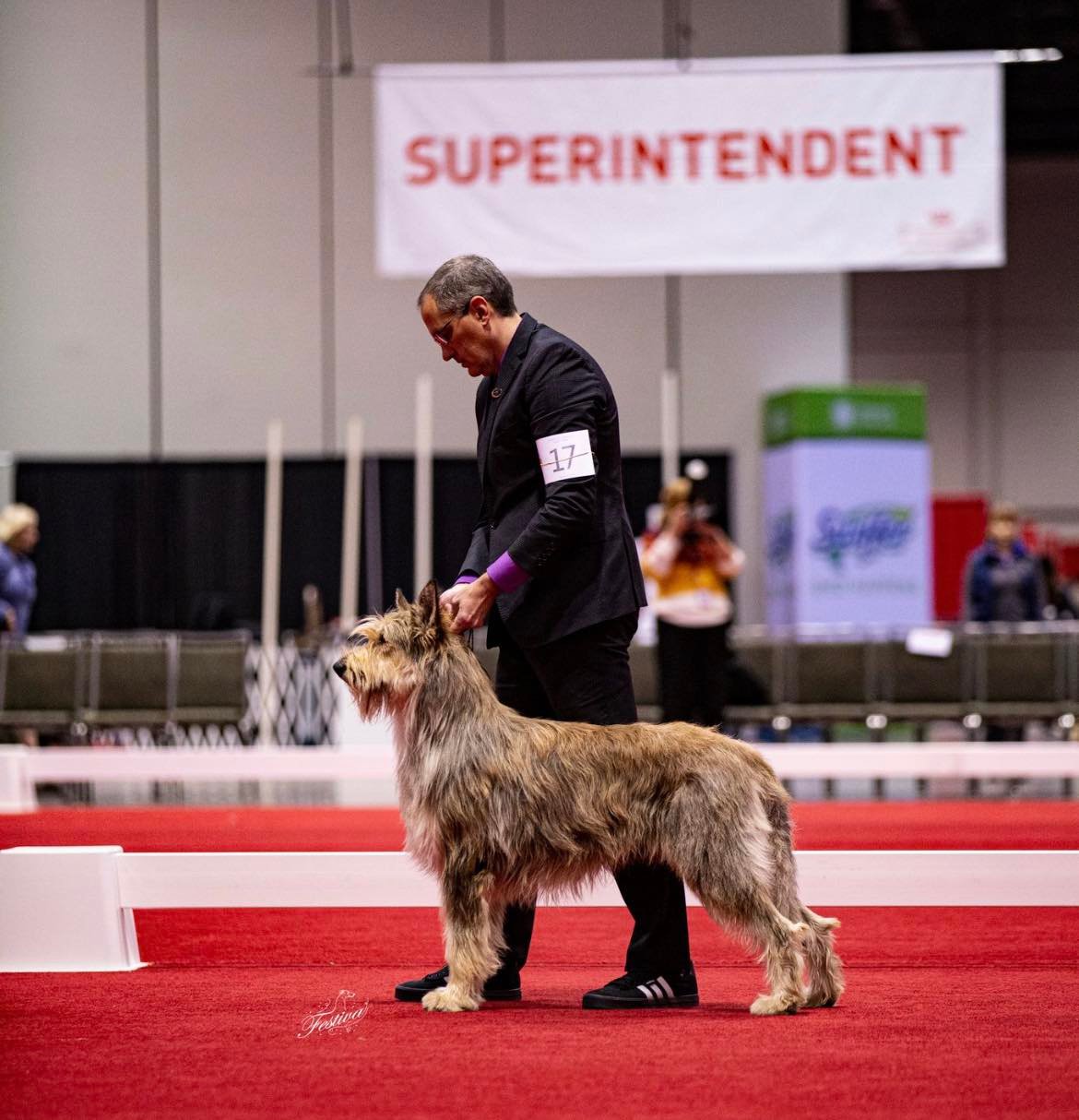
Bumble, in his glory days as the #1 Owner Handled Berger Picard, with Donna’s husband, Mike Beadle.
Bumble was lost for 10 days in the high desert of Wells, Nevada. Donna shares the lessons she learned, the emotions, the hardships, the dark humor, the kindness of strangers as well as her heartache, hope and second guessing, tips and suggestions for others in similar situations.
“If you are looking for a lost pet, especially in an area you don’t know, hire a professional,” Donna said. “They are a wealth of information. I know a lot about dogs, but I don’t know anything about lost dogs. They came they brought their trap, advised me about getting stuff out in the community. Not everybody is on social media, lost dog signs are hugely important.
“There were sightings on and around I80, which was terrifying, but that’s where we were focusing our efforts. I had to drive that interstate every day looking for my dog’s body…”
Donna traveled from Minnesota to Nevada at the first news of Bumble’s loss. She and a team of trackers, trappers, local residents, co-owners and dog community spent almost a week hunting for Bumble. After losing hope with no sightings and the tracker hitting a dead end on the trail, she returned home.

Juan, the ranch worker who first sighted Bumble, gave up his day off to help on the search and was instrumental in Bumble’s reunion with Donna.
A sighting by a ranch worker the next day brought her flying back for three more days of searching in a new area.
“Why signage and flyers are so important, the ranch owner and the ranch worker’s daughter both called because Juan saw ‘the dog in the picture,’” Donna said.
More traps, trappers and local folks restarted the search a mile back on the ranch land.
It was like looking for a needle in a haystack
Strapped into unfamiliar snowshoes, Donna traipsed through sagebrush and waist-high snow drifts in an area that they’d found new tracks in the snow. Juan, the ranch worker, came out on his day off to help with the search.
By a miracle, Donna glanced up to see her dog huddled under a small sagebrush.
Donna said, “OMG, I’ve stumbled upon Bumble.”
She was able to get a hand on him through a careful approach. He was so weak she had to carry him out. While a bodybuilder, Donna isn’t accustomed to the 6000+-foot elevation of the high desert and struggled through snow drifts until a vehicle was able to reach them.
Bumble was raced to the veterinarian, and given emergency treatment, care, and love. The extreme stress on his body caused him to crash four days later and, tragically, he couldn’t fight any longer.
564 – Owner Handler Winner: “These Dogs Are Worthy”
Owner Handler Winner: “These Dogs Are Worthy”
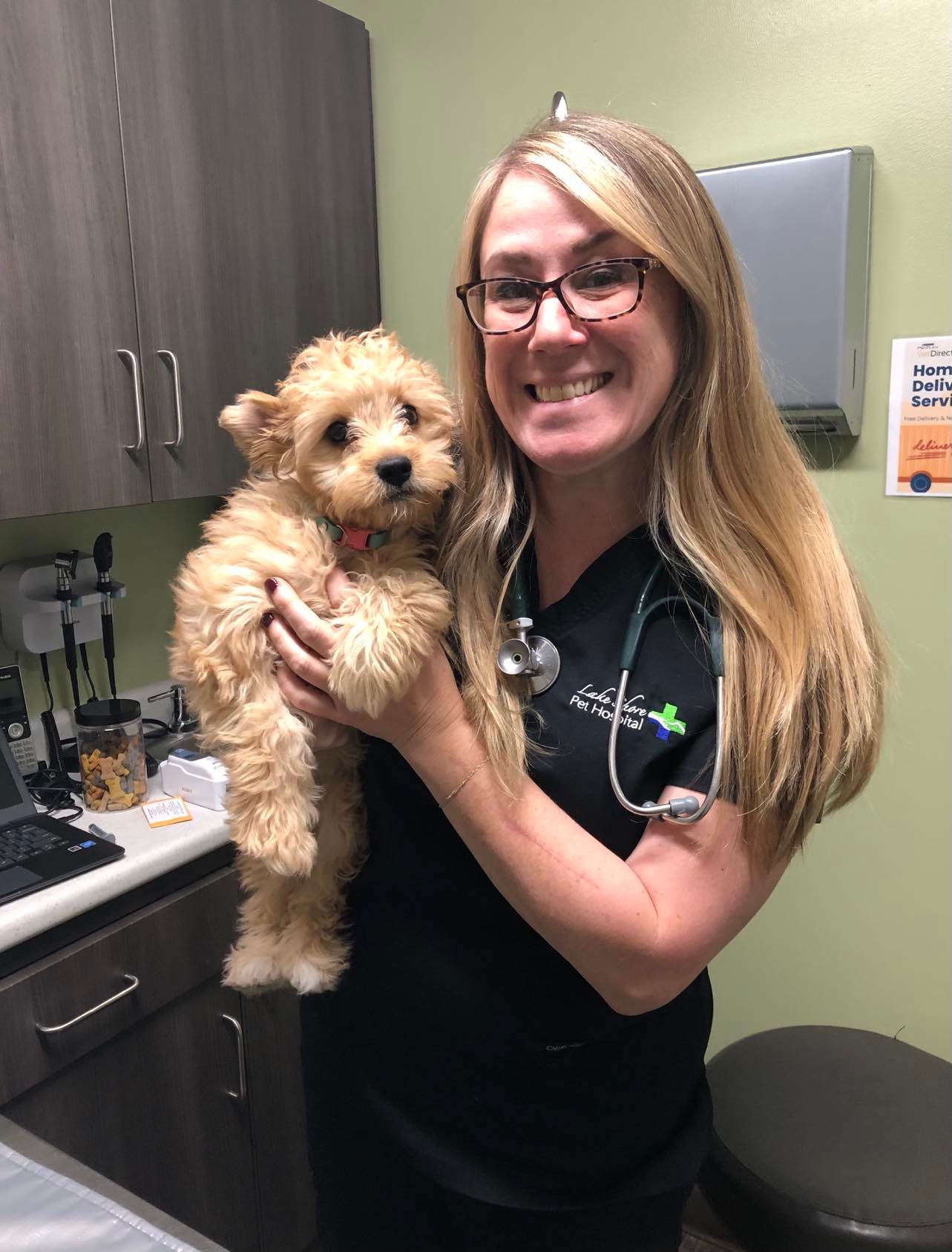
Dr. Cheryl Stiehl hard at work in her veterinary practice.
Dr. Cheryl Stiehl, DVM joins host Laura Reeves to discuss the journey that brought her to the pinnacle of the Owner Handled Series with her breeder-owner-handled Irish Setter.
Stiehl and Declan, GCHS Bramblebush Piper At The Gates Of Dawn, topped more than 825 entries in the National Owner Handled Series finals in Orlando, FL in December.
A practicing veterinarian in Maryland, Stiehl offers her life hacks for succeeding as an owner handler while working a full-time job. And she shares the love — of her dog and the sport.
“I think one of the neatest things about this dog is who he is,” Stiehl said. “His nickname is ‘The Dude.’ He’s just good for purebred dogs, if you know what I mean. He’s funny and ridiculous and silly and he loves kids and loves cats and thinks everything’s an adventure. Declan has friends and friends he has not met yet. That’s just kind of who he is. He’s a bit of a party animal. The other thing and the way I describe him when people say, ‘well, what’s an Irish Setter like, what’s this dog like?’ I say, you know the guy at the tailgate pouring shots? That’s Declan.
“I think that owner handled for me is that there was one more thing I could do with my dog. I can walk in this ring and that ring, I can do it twice. If I get nervous, I can try to work through it.
“I can take out a spleen in the OR with an animal that has a really potentially dangerous or scary prognosis and barely break a sweat. But you know, sometimes I think we all get nervous. Is the dog going to behave? Is he stacked right? Does he look OK? Am I giving him his due?
“On the other side of it too, I think the interesting part of it is your dog’s doing double duty and your dog’s going into that group ring and hopefully going into another best in show ring. So, if you were lucky to win both breed and best of breed owner handled that day, you show your dog a whole bunch and your dog has to perform a whole lot more really. I’ve actually had a few judges say that to me. You know, ‘I watched your dog today and you didn’t give up once.’ So, he is a piece of work. He’s the dude.
“The (NOHS) competition is keen. The dogs are beautiful. They are multiple best in show dogs. They are best in show dogs, they are reserve best in show dogs. They’re group placers, group and specialty winners, sires and dams of beautiful animals. These dogs are worthy. I think that one nice thing is, is it’s the connections you make. I also will say to you that I love the sportsmanship that I have experienced in those ranks. We are really happy for one another.”
Listen to the full episode for more of Stiehl’s insights on the NOHS, dog shows in general, her favorite grooming products and more.
563 – New Tufts University Course: Breeders Teaching Veterinary Students
New Tufts University Course: Breeders Teaching Veterinary Students
Gale Golden and Susan Patterson join host Laura Reeves for a conversation about the new and exciting AKC Tufts Whelping Program that provides information to veterinary students about dog breeders.
Golden, the AKC coordinator for the program, said that the growing difficulties with finding breeder-friendly veterinarians was a huge concern for her.
“As breeders, we’ve faced many challenges and still face many challenges continuing our right to breed dogs here in the United States,” Golden said. “And one of the biggest challenges has been not only the lack of veterinary care, but the lack of understanding of the purebred, responsible dog breeder and how we work and operate. And that has led to, in some instances, lesser care breeders have available to them or even, in emergency situations, outcomes that weren’t the desired outcomes.”
Change the Conversation
Patterson, who has worked with a similar program at the Ohio State University, noted that “we need to change the conversation at the vet school level. How do we show that students, who most likely have never whelped a litter, will never do anything but triage, what a responsible breeder does, what their parameters are, how they make their choices, and how do they whelp their puppies.
“So, we are going directly to the students, who have some pre-formed opinions, but they have no experience. And we are sharing super transparently all the good, the bad, the ugly. We’ve worked with (the staff advisor) to develop what they call a selective, which in normal academic terms would be called an elective. They get to choose. And so, this last semester we had three students, this semester will have five.
“The other thing we’ve done that I think has added tremendously is we’ve not just focused on these students, but we have opened up our monthly roundtables to all interested vet students and we have brought in veterinarians. We had them in the classroom and we did have a virtual crop and dock just because of timing.
Talk About the Hard Things
“So, we’ve addressed the hard things. We’ve talked about what it takes to produce a puppy that is going to be healthy. And why we do the testing, why we make the choices, why temperament and different breeds. And so they’ve been able to ask us really hard questions. And I think the interaction has been very positive.”
“The total lack of understanding of what a purebred dog was and how they came to be and why they came to be” was an “aha” moment for Golden. She noted that one of the important topics covered in the course is the breed standard. “What is the breed standard and how did it come to be. The fact that they didn’t know was a real aha for me.
“The other thing I don’t feel like they really understood was how we preserve a breed. And as I’m sure most everyone here knows, French Bulldogs have been just bombarded with every kind of influence from outside the breed gene pool there could be. And it’s like a breed being attacked on steroids, you know, from fluffy to pink. It all exists. One of the scary statistics for this breed is last year there were 32,000 Frenchie litters registered with the AKC. 294 were parent club members, 294 out of 32,000. And since DNA really can’t accurately show us exactly what’s behind a dog, after a few generations of breeding to Frenchies, it looks like it’s a purebred Frenchie.
“Another aha for me was the health testing process, the Orthopedic Foundation for Animals, that it exists. What kind of data was there, who loads that data and that it is a partnership with veterinarians and breeders that actually populates that database and how we use it to make improvements. So those things were major ahas for me.
“The preservation message, however, is one that resonates for us. We don’t tell our own story. You know, we’re kind of invisible. There might be 90,000 of us in Massachusetts playing dog sports, but I find out legislatively many times we’re invisible. You know, the fact that we let other people tell our story is a problem.”
562 – Applied Structure and Anatomy LIVE in Utah
Applied Structure and Anatomy LIVE
Join the live studio audience with host Laura Reeves at Bonneville Basin Kennel Association to discuss why our dogs are built the way they’re built. Laura and members of the audience address structure and why our dogs are built the way they’re built.
Form and Function go together
There are a lot of differences between herding dogs, depending on the type of herding they did, according to AKC judge and Pumi breeder Chris Levy.
Tonia Holibaugh Cruz
A lot of people think “oh it’s a toy dog, structure doesn’t matter.” What happens is that as companions, these dogs need to be able to live to 10 or 11 years old and still be able to make it to the food bowl. Your expectations of a Pekingese cannot be the same as your expectations of an Italian Greyhound. Even though they’re all toy breeds, their purpose is completely different. The construction is different, therefore their abilities (are different.)
Linda Culver
A properly constructed Italian Greyhound can be just as sturdy as a Whippet
Carma Ewer
I love to see a beautiful schnauzer moving around the ring with great reach and drive, but you don’t have to have great reach and drive to kill a rate. We are starting to lose some of our other qualities. We have to have strong teeth, muzzle and head to be able to do the job. You need to have good bone, muscle tone, don’t want the rat pulling your dog in the hole because it’s so weedy.
Lydia Hovanski Lyon
Tail placement on these terriers is so important. My Fox Terrier, when it goes to ground, and it’s pulling out a fox, I have to be able to grab it by the tail and pull it out, to help it. If we can’t grab onto those tails, that dog is useless and going to die. With the dogs that are going to ground, it is essential to pick them up by their tail. It’s showing they can do the job.
Hear more on this topic when host Laura Reeves presents on Form and Function at Breedercon this weekend at the IKC show in Schaumburg, IL. Sign up for the seminars HERE.
561 – 4Ever15: Choose Kindness
4Ever15: Choose Kindness
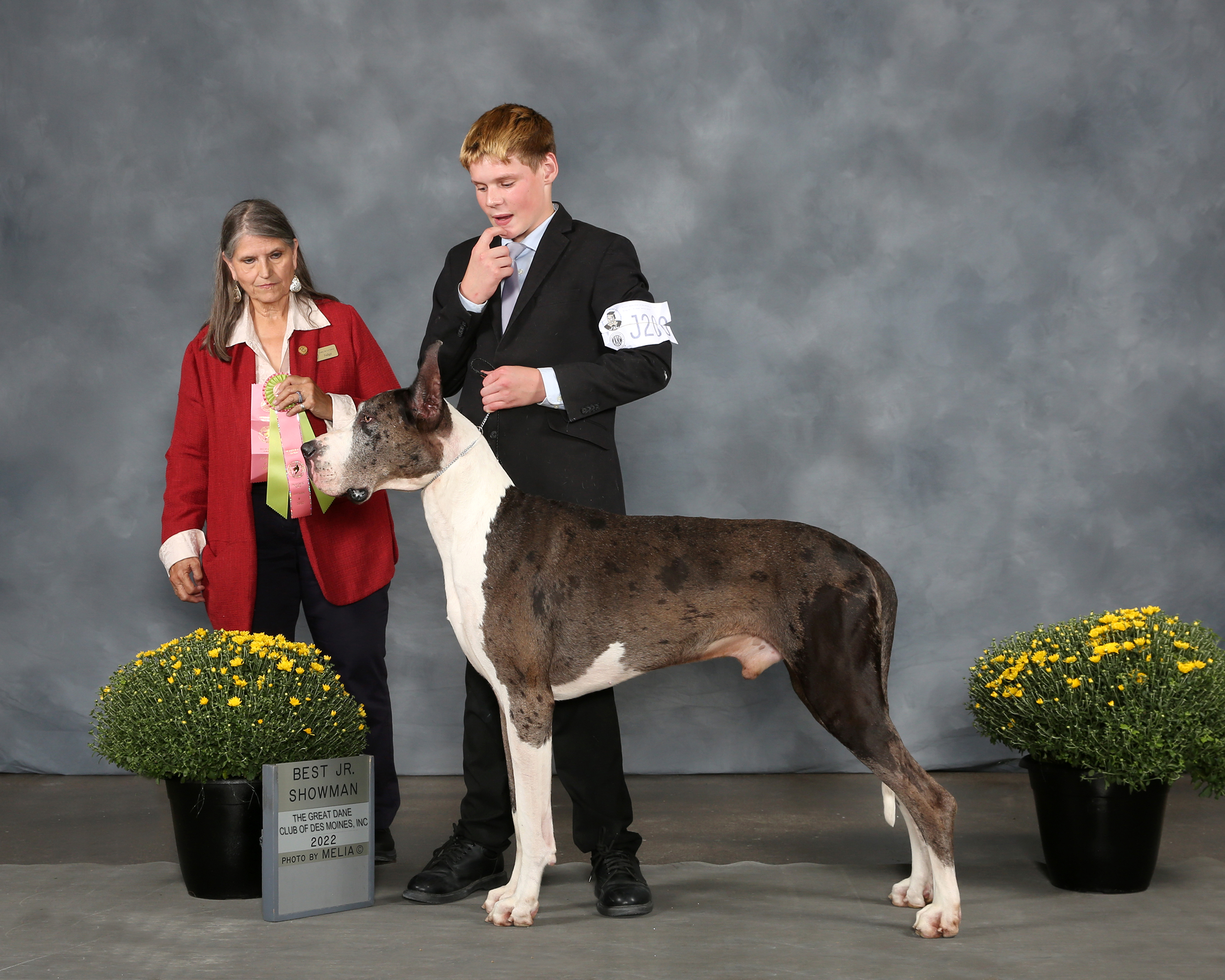
Nick Carroll winning Best Junior Handler at the Great Dane specialty in Des Moines, IA.
Denise Carroll joins host Laura Reeves to share her story of how the twin epidemics of school bullying and teen suicide affected her, after her son, Nick, took his life last month.
Nick Carroll was Denise’s adopted son whose happiest place was dog shows. He had friends and projects and felt safe, showing Great Danes in the breed ring and Juniors.
“It didn’t matter who was competing,” Denise said. “He would cheer you on no matter what. If he lost in juniors he’d still cheer on his friends. The friendships he made at dog shows were really close ones. He maintained some really good friendships.”
But his school life was another matter. Denise said that Nick was routinely bullied at school, including additional attacks around his service dog.
- The 2019 School Crime Supplement to the National Crime Victimization Survey (National Center for Education Statistics and Bureau of Justice) indicates that, nationwide, about 22% of students ages 12–18 experienced bullying.
“What I feel is, when Nick started taking the dog to school is what made him an easy target. School was the biggest issue for him,” Denise said.
How to avoid costing someone their life
“The biggest thing is to realize what we’re all struggling with something,” Denise said. “You never know what someone is going through at the time. So, you should try to be kind. In today’s society, people can hide behind their phone, be anonymous and say things and not have consequences for their actions.”
More survival tips from Denise:
- Today’s kids have gone through a lot more trauma than kids did when I was growing up.
- Walk a mile in someone else’s shoes
- Parents need to talk to their kids, that a difference in someone else isn’t a bad thing
- Parents don’t communicate with kids. Kids have electronics that are their parents. They don’t talk with mom and dad or sit down and have meals together.
Statistics from the Suicide & Crisis Center of North Texas:
-
Suicide is the third leading cause of death of young people between the ages of 15 and 24.
-
5,000 young people complete suicide in the U.S. each year.
-
Each year, there are approximately 10 youth suicides for every 100,000 youth.
-
Each day, there are approximately 12 youth suicides.
-
Every 2 hours and 11 minutes, a person under the age of 25 completes suicide.
-
In the past 60 years, the suicide rate has quadrupled for males 15 to 24 years old, and has doubled for females of the same age.
-
For every completed suicide by youth, it is estimated that 100 to 200 attempts are made.
“We went to Orlando (for the AKC National Championship),” Denise said. “It was bittersweet because Nick was supposed to be with us. I took some friends of Nick’s and his sister to Sea World. We’d laugh for a while and somebody would say Nick would have loved this. At one point, the four of us just hugged each other and cried. It was special because they loved him just like we did.
“Christmas has been hard,” Denise said. “I put off wrapping presents because I had presents for him that he’ll never open….”
Nick’s Message:
Be helpful and kind.
“His shining moments were when he was helping people,” Denise said. “I want more people to be like that. To give to others. And not be takers and just do what’s best for you. We could all take a page from Nick’s playbook.”
To offer condolences or support, contact Denise directly.
560 — Lessons from Orlando and Holiday Musings
Lessons from Orlando and Holiday Musings
The extravaganza of purebred dogs that is the AKC National Championship week in Orlando has come to a close. I skipped the last couple years with the pandemic and all that entailed, so it was really good to be back with the people I so rarely get to see.
I think we all learn something new each time… Like how it’s possible to walk 10 miles and never see the sky…. Or just how many shiny suits St. Johns actually makes…. Or what we jokingly refer to as “snacks in Orlando” … where a cheeseburger, an appetizer and two drinks costs $100….
But there are some actually useful lessons to be learned, some that happened to friends, some observed, some that have happened to me over the years, so here we go.
Wait, my dog is HIGH?
First up, dogs put ridiculous things in their mouths. Even at high-end hotels, be observant and careful when letting your dog roam free in the room. My friend Ingrid learned this lesson the very hard way this week when her Chihuahua found and ingested marijuana in a hotel room on her trip to Orlando. She is now extremely aware of the signs of cannabis toxicity in dogs….
This has become something of an epidemic at veterinary practices, according to Dr. Marty Greer. So, for those who haven’t experienced this, here are some tips. Also, take a listen to our past podcast on the topic of how cannabis can be useful in treating dogs in forms that do not contain THC.
Cannabis contains more than 100 different chemicals (or compounds) called cannabinoids. Tetrahydrocannabinol (THC) is the cannabinoid that has the most psychoactive effects. It is also the compound responsible for some of cannabis’ medicinal uses, such as treating nausea and improving appetite in cancer patients. Other compounds, such as cannabidiol (CBD), have shown promise for medicinal use and do not have psychoactive effects.
Dogs have more cannabinoid receptors in their brains, which means the effects of cannabis are more dramatic and potentially more toxic when compared to humans. A small amount of cannabis is all it takes to cause toxicity in cats and dogs.
Per VCA Animal Hospital, most of the signs of intoxication are neurological. Pets may become wobbly and uncoordinated. They may be hyperactive or sleepy, disoriented, and/or very vocal. Their pupils may dilate, giving them a wild-eyed appearance, and they may drool excessively or vomit. They may also develop urinary incontinence (i.e., urine leakage). In severe cases, tremors, seizures, and coma can result.
Physical signs include slow or fast heart rate, altered blood pressure, and slowed respiration rate (breathing rate). Lethargy and increases or decreases in body temperature may also be observed. Fortunately, these side effects are usually short-lived but they can still be dangerous and make your pet quite miserable.
Diagnosis is based on an accurate history and clinical signs. Although there are tests to determine the level of THC in the urine, the results take time, making them impractical. Human urine drug screening tests are quicker but are not dependable in pets. The diagnosis is made much more quickly, and treatment initiated, when responsible pet owners provide accurate information regarding the pet’s exposure.
When a toxin enters the body, often the first line of defense is to get it out. If the toxicity is discovered shortly after ingestion, your veterinarian may induce vomiting to prevent further absorption of the toxin.
Two factors may interfere with this early defensive strategy. First, the signs of toxicity may manifest only after the drug has been absorbed, meaning it is already in the system. Second, cannabis has an anti-emetic effect that inhibits vomiting. In life-threatening cases, the stomach may be pumped (gastric lavage). Activated charcoal may be administered every six to eight hours to neutralize the toxin. Enemas are also used to reduce toxin absorption from the gastrointestinal tract.
The second line of defense in cannabis toxicity involves providing supportive care until the effects of the drug wear off. Medications and supportive care to regulate your pet’s heart rate, respiration, and body temperature are used if needed. Since your pet may be lethargic, with no desire to eat or drink, IV fluids can help prevent dehydration, support blood pressure, and maintain organ function. Anti-anxiety medications can minimize agitation. Gastrointestinal treatments may be needed for nausea or vomiting. To prevent self-trauma while your pet is disoriented and uncoordinated, confinement in a safe, comfortable space is helpful. Noise should be kept to a minimum to decrease sensory stimulation.
If cannabis is ingested with toxic or problematic substances, such as xylitol, chocolate, raisins, or foods containing a lot of fat, supportive care or additional treatments may be required to treat conditions associated with the ingestion of those substances.
Pro Tip
Next, carpets are slippery! The AKC National Championship show, Westminster Kennel Club, and many of the biggest shows in the country feature beautifully carpeted rings to showcase the dogs. Experienced exhibitors know that dogs don’t move well on the carpet because their feet slip and they can’t drive off their rears. Even in a stack, dogs can have trouble holding their normal position. The best solution to this problem is to keep the dog’s feet wet. Spray bottles of water or wet towels will soften the hard pads enough to give the dog a grip on the carpet. This will allow you to showcase your dog to its best advantage on that gorgeous red carpet.
Your feet also need some consideration…. We’re putting in LOTS of hours on our feet… moving, standing, running, walking. Your entire body depends on those feet, so take care of them. Change shoes midday. Just the slightest shift in fit makes an enormous difference. I’m given rations of grief about my “shoe suitcase” but I promise, if I had taken better care of my feet when I was younger, it’s a good bet I’d live with less pain today…
Third, we would all do well to learn lessons from the best junior handlers in the country. They are supportive and outstanding sports, they cheer for each other, they encourage each other, they tease friends through bouts of nerves. They are composed under immense pressure, they are driven to succeed, they ooze talent and dedication. They may or may not be the future of the sport, but *their* futures will be immensely improved by the lessons they take away from the sport and incorporate in their daily lives.
We hear an awful lot about millennial this or teenage entitlement that, but when you see these young men and women working their butts off, sprinting over miles of concrete, competing at the highest level and often working ridiculous hours for handlers to support their dreams, you are left with a much different understanding of our youth. The best and brightest of these kids will shine no matter where their life’s journeys lead them.
Redemption is a Thing
Winston Churchill’s oft repeated quote is more fitting to our sport than most…
“Success is not final; failure is not fatal: it is the courage to continue that counts.”
Watching friends battle back from injuries, defeats, disappointments and setbacks has been inspiring for me, particularly this year. Kelly Shupp, who just handled our Spinone to win the Sporting group here, shattered her ankle in September and we really didn’t think she’d even be walking by this time. She fought through pain and frustration and disappointment and dedicated herself to being on the end of Josie’s leash to wrap up what had been a history making year already. Her strength and determination and sheer will power literally bring me to tears of awe.
Sharing is Caring
Whether it’s the YaYa Sisterhood of the traveling outfits when you win the group and didn’t expect to or a corner of a grooming space in a crowded building, this sport really can bring out the best in us. I treasure the people and friendships built over my lifetime in this sport.
I know there are Debbie downers out there, but I firmly believe that our lives are immeasurably richer when we focus on the positive and find the beauty around us. It’s lots easier to do that if you simply avoid and/or ignore the folks who would burst that bubble.
Big Trips are Exhausting
Having driven cross country innumerable times, in various vehicles, daunting weather and impossible schedules, I offer a few words of wisdom.
- Plan ahead. If something can go wrong, it will and at the most inconvenient time. Have backup plans for your backup plans. Pay attention to the weather apps. I used weather underground to route around upcoming storms. Adding an extra few hours or even a day to the trip to travel safely saved me countless headaches. Factor that into your planning. If you don’t need the extra day to arrive safely, you can always use it to relax and have a little fun on the journey.
- Sleep more and eat less. I always stop for a good night’s sleep. I need it to be safe on the road. And the dogs sleep better when the rig isn’t moving. I snack a lot when driving but rarely eat huge meals. I also stop every three to four hours to x dogs, get fuel, walk a little, stretch and keep the blood moving.
- Listen to a podcast! Lol
Thank YOU…
In closing, as we end the year of competition and transition into the holidays, I wanted to take this opportunity to thank you guys. It’s been 6 years now of talking to y’all. I was stopped this week by a lovely young man with a Barbet. He shared with me that the whole reason he was at the show was because of the work we do here. That he’d discovered the breed because of our episode with Judy Descutner. That the podcast gave him the tools and encouragement to stick with it. That brief conversation was the best gift ever.
And it’s those stories, YOUR stories, that keep me keepin’ on. So, thank you for taking us along …. On your road trips, your workouts, your grooming sessions, and your lawn mowing. I’m looking forward to a whole new year of sharing fabulous stories with you.
And I hope you’ll join us on the first Tuesday of every month for the live podcasts on the Facebook page, LIVE@5. If you haven’t had a chance, stop by Pure Dog Talk and join our Patrons getting their Pure Pep Talks.





